In the world of fine jewelry, the champagne diamond has swiftly ascended as 2023’s jewel par excellence, capturing the imagination of both celebrities and discerning aficionados. This rise mirrors the cultural zeitgeist shaped by the hit television series “Succession,” renowned for its portrayal of a wealthy media dynasty where subtlety in luxury reigns supreme. Embodying this “quiet luxury” aesthetic, champagne diamonds blend understated elegance with a contemporary edge, making them the gem of choice for trendsetters like Kate Hudson and Kristen Bell. We’ll delve into the captivating journey of the champagne diamond, celebrating its newfound status as a symbol of modern sophistication and the discreet charm of the affluent, much like the characters in “Succession.”
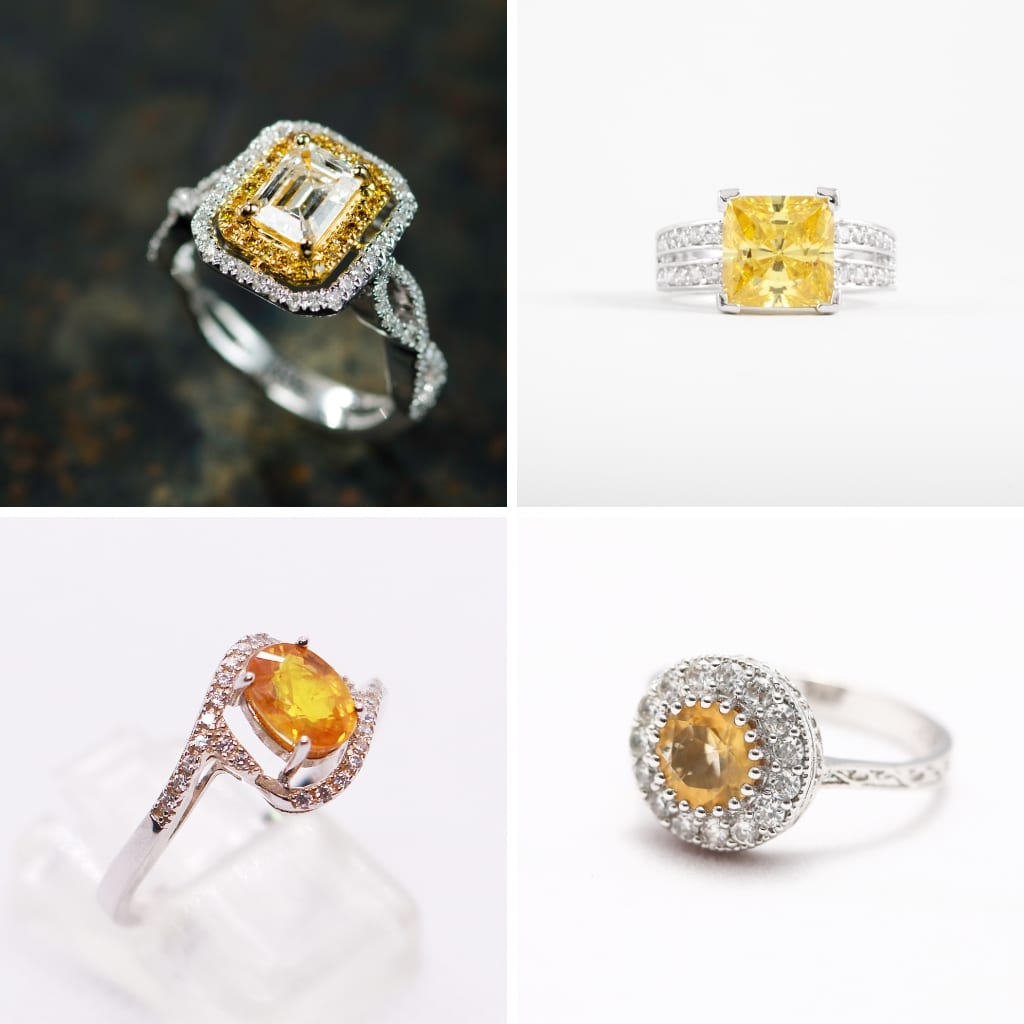
I did a deep dive into the best places to buy champagne and yellow diamonds and recommend the following online diamond sellers.
- James Allen Champagne and Yellow Diamond Rings
- Blue Nile Champagne Diamonds Rings
What is a Champagne Diamond?
A champagne diamond is formed when the nitrogen trapped inside the carbon bodies manifests itself through gentle golden brown and yellow colors.
This creates the unique and aptly-named champagne diamond. Higher amounts of nitrogen result in a darker brown, which are sometimes referred to as cognac diamonds.
In addition to extra nitrogen, the color can also result from defects in a diamond’s crystal lattice, which causes it to absorb different light wavelengths.
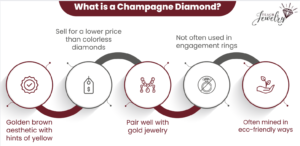
While the shades, overtones and undertones may vary, these are highly prized and sought out for their attractive yellow and brown appearance.
Champagne diamonds come in all the same shapes as other diamonds: oval, marquise, round, pear, and more.
They have the same general structure as traditional diamonds, and though colorless diamonds are more valuable, champagne diamonds may be the right fit for someone looking for a unique fancy colored diamond.
Where are Champagne Diamonds Sourced?
Historically, champagne diamonds, which are essentially brown diamonds with a yellowish tint, were not highly valued in the diamond market. They were often seen as inferior to the more desired white or colorless diamonds and were typically used for industrial purposes. This perception changed dramatically in the 1980s, primarily due to the efforts of the Argyle Diamond Mine in Australia.
Argyle, which produced a large quantity of these brown diamonds, began a targeted marketing campaign to rebrand them. By assigning them appealing names like “champagne” and “cognac,” these diamonds were presented not as low-grade, but as unique, fashionable, and desirable. This rebranding aligned them with luxury and exclusivity, much like the beverages they were named after.
The strategy was remarkably successful. It shifted public perception and created a new market for these diamonds. Consumers began to see champagne diamonds as a stylish and distinctive choice, different from the more common white diamonds. This shift was bolstered by their appearance in high-end jewelry and endorsements by celebrities, which further solidified their status as desirable gems.
This case is a classic illustration of how marketing can alter the perceived value and desirability of a product. By changing the narrative around champagne diamonds, marketers turned a previously undervalued product into a sought-after luxury item.
More Affordable
Although colored diamonds are often attractive, they have yet to gain precedence over the traditional colorless stones. This means the price is lower than a colorless diamond of the same carat, cut, and clarity.
If you shop based on your taste and not the mainstream conscience, champagne diamonds are the perfect fit. They’re more easily obtained and fetch a smaller price than some purple and blue diamonds.
Like any stone, the cost varies depending on the actual grade of the color. The most flawless champagne diamonds can go for significant multiples over lower-quality ones.
As a general rule, the darker and more rich the hue, the higher the price will be. They can be found in Faint, Light, Medium, and Dark shades.
Unique Color Shade
The striking yellow and brown of champagne diamonds is a unique color shade that grabs attention.
Because the intricate patterns that run through diamonds are still present in colored stones, the golden glow is refracted in a stunning display as well as any other diamond.
Once you hit darker shades, you may find them labeled as a cognac diamond, as the brown begins to overpower the light yellow that infuses the gem.
Pairs Well With Gold
What’s a diamond without a setting to match? The unique color of champagne diamonds matches well with almost any type of band, setting, or material. That being said, it’s common to pair champagne diamonds with a gold setting.
Whether it’s rose, peach, or yellow gold, the light or dark brown and yellow tints of a champagne diamond are the perfect complement.
Eco-Friendly
There hasn’t always been a strong demand for champagne diamonds. Colorless diamonds are the most sought after in the market, so darker ones were traditionally thrown out because they wouldn’t sell.
But because there’s now demand for champagne diamonds, these don’t have to be discarded. That makes them a more eco-friendly type of diamond.
What to Look for in Champagne Diamonds
If you’re interested in buying a champagne diamond, you should examine its qualities in the same way you would other diamonds:
- color
- cut
- clarity
- carat
These characteristics mark the quality (or lack thereof) of any diamond, and it’s always best to have it certified by the GIA.
Color
The distinctive feature of a champagne diamond is its color, so this characteristic is the focus point of many buyers. Although it’s easy to say a champagne diamond is just yellow and brown, that doesn’t cover the range of these stones.
The amount of time spent under pressure and the difference in nitrogen levels result in varying degrees of saturation for both the undertones and overtones alike.
They may span from the lightest brown to a deep cognac, but a secondary hue also accompanies the primary color. This can appear as shades of pink, orange, and yellow.
The GIA doesn’t use the term “champagne diamond” in its report, but you can identify them if they’re labeled:
- Faint Brown (K-M on the color scale)
- Very Light Brown (N to Q-R)
- Light Brown (S-T to Y-Z)
The GIA says brown diamonds that fall outside its traditional D-to-Z scale can receive the following grades, depending on their tones:
- Fancy Light Brown
- Fancy Brown
- Fancy Dark Brown
Or if your diamond is more on the yellow end of the spectrum, it could be graded on the GIA color scale as N or below. These colors are considered Very Light or Light.
Cut
Cut refers to the overall quality of several characteristics, including its polish, symmetry, brilliance and fire. It affects how well the diamond sparkles and its light performance.
While it’s essential to have at least “good” cut for a colorless diamond, cut is viewed differently for a champagne diamond.
That’s because it’s darker shade diminishes its brilliance and sparkle, even if it were the highest graded cut.
So you shouldn’t pay a premium price for the best cut available, because it’s performance won’t be worth the increase.
For a champagne diamond, choose a cut that enriches its hue and doesn’t result in dullness.
Clarity
A diamond’s clarity grade indicates the number and degree of inclusions (blemishes). For champagne diamonds, the GIA assigns the following grades, as it does with other diamonds:
- Flawless – FL
- Internally Flawless – IF
- Very, Very Slightly Included – VVS1 and VVS2
- Very Slightly Included – VS1 and VS2
- Slightly Included – SI1 and SI2
- Included – I1, I2, I3
It’s rare to find a flawless champagne diamond or even one without many inclusions. If you do find one, the seller will make sure you pay.
VS1 to VS2 grades are “eye clean,” meaning to the naked eye they appear to have no flaws, inside or out.
While you can always shoot for better, VS2 champagne diamonds are nothing to scoff at. The deep and complex hues have the effect of shrouding any otherwise noticeable defects.
Carat
While cut and clarity offer shortcuts to a diamond’s sparkle, carat always has a significant impact on price. While you can expect the price of any diamond to increase with its carat, this is less so for champagne diamonds.
That means you can get a higher carat for a lower price than a more traditional diamond.
When it comes to carats for a champagne diamond, don’t go for the largest stone in your budget.
Carat really makes a visual impact when the diamond already has strong sparkle and brilliance, and when you’re purchasing a champagne diamond, those aren’t the qualities to expect.
Instead of buying a heavier champagne diamond with a darker, toned-down look, we recommend one between 0.5 and two carats that still shows some brilliance.
Prices
Quality diamonds never come cheap, but compared to colorless diamonds, champagne diamonds are a bargain because they aren’t as rare.
Though there’s demand for champagne diamonds, colorless still rules the market, so you’ll get a discount for a fancy colored diamond.
As a comparison, below are two diamonds from Blue Nile that have the same carats, cut, and clarity, but one is a champagne diamond and the other has a G color (near colorless).
The champagne diamond costs $1,499, and the near colorless one costs $3,718.
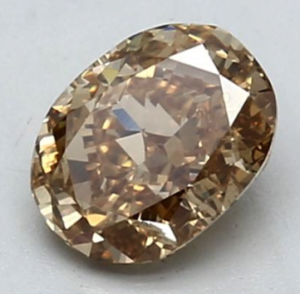
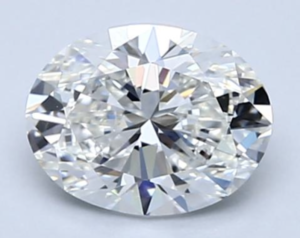
All else being equal, a champagne diamond is significantly cheaper than one approaching colorless.
You can expect the price of a champagne diamond to increase in the same way as other diamonds. As you move to higher carats, cut, and clarity, the price goes up.
In regard to champagne diamond color, darker, deeper browns are generally more expensive.
Where to Buy Champagne Diamonds
There are online and in-person jewelry retailers where you can buy a champagne diamond. They’re offered on the full range of the color spectrum, in addition to varying carats and settings.
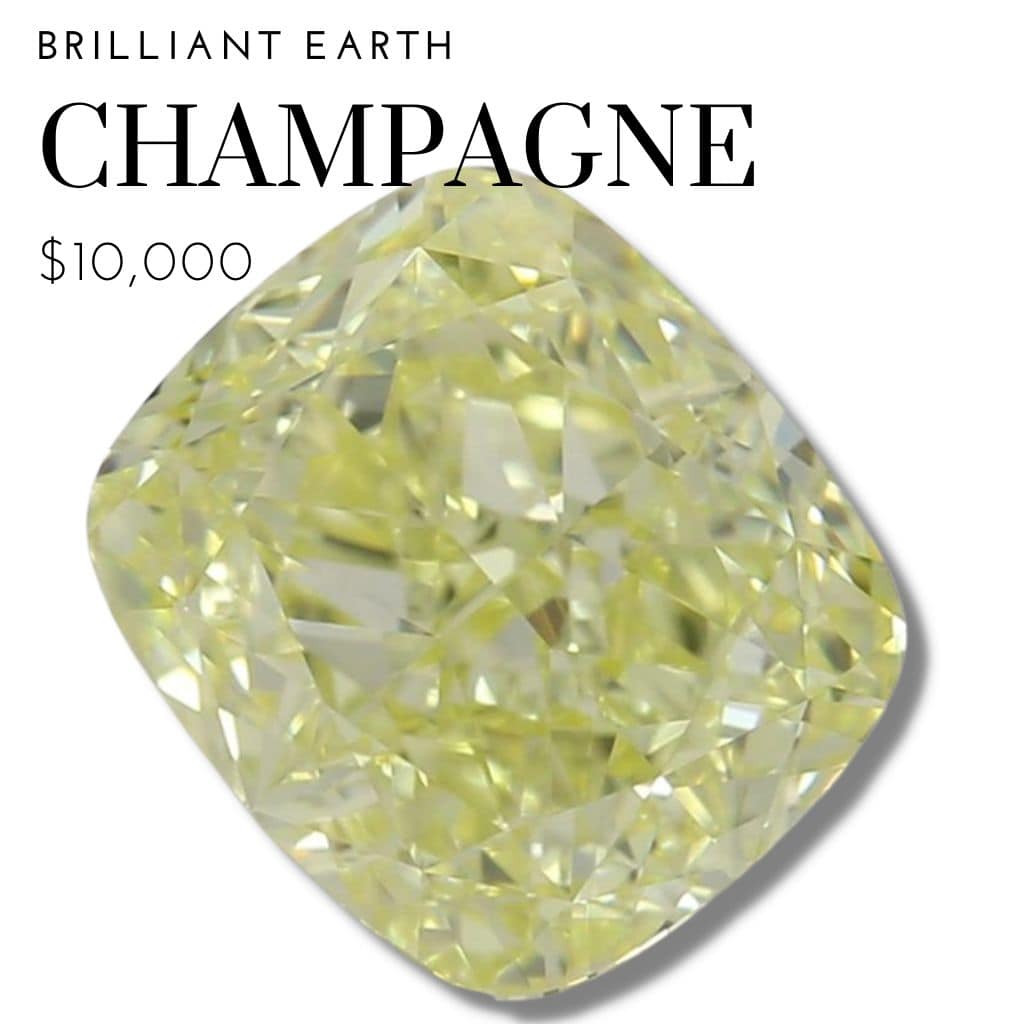
Brilliant Earth is another reputable seller of champagne and yellow diamonds. We found this 1.8 carat yellow/champagne diamond for $10,000. They have many others to choose from.
- Brilliant Earth Champagne/Yellow Diamonds on Sale
- James Allen is one of the most price competitive on Champagne and Yellow Diamond Rings
- Blue Nile offers a nice selection of Champagne Diamonds Rings
Key Highlights:
- Peak in Popularity: According to Google Trends, the search interest for champagne diamond jewelry reached its peak in early 2023. This surge in interest is now being reflected in the choices of consumers, with jewelers like VENVS founder Haley Biemiller reporting an uptick in requests for champagne diamonds in both custom designs and ready-to-wear pieces.
- Unique Appeal: Champagne diamonds are valued for their warm, sparkling, and bubbly appearance, reminiscent of a glass of fine champagne. These diamonds, with their warm tones including browns, reds, oranges, and champagne colors, offer a way to add a bit of color to engagement rings while maintaining a neutral and sophisticated palette.
- Affordability and Versatility: In terms of diamond pricing, champagne diamonds are comparably priced to regular clear diamonds. $10k diamonds seem to be the sweet spot of balancing quality and price. However, because of their darker color, champagne diamonds can be a more affordable option, as they can conceal inclusions better than clear diamonds, allowing for the selection of lower-quality stones without compromising on appearance. Many people consider a 1 carat diamond to be the perfect balance of size vs price, however, 2 carat diamonds are becoming more common.
- Metal Pairings: When it comes to setting champagne diamonds, jewelers advise against pairing them with white gold due to its cooler tone. Instead, they recommend metals that complement the warm hues of the diamond, such as yellow or rose gold. Ultimately, the choice of metal and design is a matter of personal preference, reflecting the individual style and taste of the wearer.
Celebrities with Champagne Diamond Engagement or Wedding Rings
Champagne diamonds, have found their way into the hearts of celebrities, leading to some notable and exquisite engagement and wedding rings. These diamonds offer a departure from the traditional white diamond, providing a touch of individuality and elegance that resonates with those in the limelight. Here are a couple of celebrities who have embraced the charm of champagne diamonds in their rings:
- Kate Hudson: The renowned actress subtly confirmed her engagement to Danny Fujikawa at the Met Gala, where she debuted her champagne diamond engagement ring. This ring, crafted by Lorraine Schwartz, is a testament to the sophistication and contemporary style that champagne diamonds can bring to traditional engagement jewelry. The ring is estimated to be worth close to $1 million. It has a 10 carat champagne-colored diamond with a fine diamond-set band. Hudson’s choice highlights the growing trend among celebrities to opt for unique and colored diamonds that reflect their personality and style.
- Kristen Bell: Known for her roles in both television and film, Kristen Bell is another celebrity who chose a champagne diamond for her engagement. Her ring, crafted by celebrity jeweler Neil Lane, features an unusual emerald-cut champagne-colored diamond. The stone is surrounded by pave diamonds set on a platinum or white gold band, combining the timeless elegance of traditional diamonds with the distinctive charm of a champagne hue. This choice underscores a preference for individuality and the allure of colored gemstones in celebrity engagement rings.
Other celebrities have also been known to showcase champagne diamond jewelry. Shawna Thompson flaunted her “Champagne Bubbles” diamond earrings, and Sheryl Crow wore a Champagne cougar diamond ring at the 2012 Tony Awards, demonstrating the versatility and appeal of champagne diamonds in various forms of jewelry.
These examples of champagne diamond rings among celebrities not only reflect their personal taste but also signify a broader acceptance and appreciation of colored diamonds in high-profile engagements. The allure of champagne diamonds in celebrity circles can be attributed to their unique color, rarity, and the statement they make – a blend of luxury, uniqueness, and a touch of unconventional beauty.
Famous Champagne Diamonds
One of the most renowned champagne diamonds is the Golden Jubilee. Discovered in the Cullinan Mine in South Africa in 1985, this spectacular stone weighed an original 755 carats in the rough, later faceted to a remarkable 545.67 carats, making it the world’s largest faceted diamond. Initially known as the “Unnamed Brown,” its transformation into a symbol of royal grandeur was complete when presented to the King of Thailand in 1997, in honor of his 50th coronation anniversary. The Golden Jubilee, with its fascinating journey from an unassuming brown diamond to a royal gem, is valued between $5 million and $12 million.
Another celebrated champagne diamond is the Golden Pelican. This 69.93-carat gem, also hailing from South Africa, is known for its rectangular emerald cut. Showcased in a 14-karat gold band, it gained significant attention when auctioned by Christie’s in the 1970s. Today, its estimated value is around $3 million, a testament to its rarity and exquisite beauty.
Comparisons with Other Diamonds
Champagne diamonds, with their unique hue and charm, stand in a league of their own within the wide spectrum of diamond varieties. Comparing these captivating stones with other types of diamonds—such as traditional white diamonds, exotic black diamonds, or vividly colored diamonds—highlights their distinct qualities and appeals to a diverse range of tastes.
- White Diamonds: The most obvious comparison is with traditional white diamonds, which are prized for their lack of color and their brilliance. While white diamonds have been the classic choice for centuries, champagne diamonds offer a warm, rich alternative. The contrast lies in the allure; white diamonds reflect light in a dazzling display, whereas champagne diamonds absorb and refract light, giving a deeper, subtler glow.
- Black Diamonds: Black diamonds, another unique variety, offer a stark contrast to champagne diamonds. Known for their bold, opaque color and distinctive look, black diamonds cater to a more modern, edgy aesthetic. In comparison, champagne diamonds exude a softer, more romantic appeal, often favored for their vintage feel and elegance.
- Colored Diamonds: Colored diamonds, such as pinks, blues, and yellows, each have their own charm and rarity. Champagne diamonds, with their spectrum from light brown to deep cognac, provide a more understated yet equally captivating alternative. While brightly colored diamonds make a bold statement, champagne diamonds offer a sophisticated subtlety.
Champagne diamonds epitomize a blend of rarity, elegance, and contemporary sophistication, echoing a cultural shift towards unique and personal expressions of luxury. Their ascent from being undervalued to becoming coveted gemstones illustrates the transformative power of perception and marketing within the luxury goods sector. The embrace of champagne diamonds by celebrities and the public alike signals a broader trend in the appreciation of diverse and nuanced beauty in fine jewelry. As we reflect on the journey of champagne diamonds, from industrial-grade stones to symbols of quiet, luxurious splendor, it becomes evident that they are more than just a fashion statement. They represent a deeper appreciation for understated elegance and individuality in an age where these qualities are increasingly valued. The story of champagne diamonds, much like the effervescence of the drink they are named after, is one of unexpected delight and enduring charm, making them a timeless choice for those seeking to make a subtle yet powerful statement.

Jacob Clarke
Jacob Clarke is the founder of TeachJewelry.com.
He earned an Applied Jewelry Professional Diploma from the Gemological Institute of America (GIA) and now brings you essential information about diamonds, settings, and more.
Jacob has consulted with leading jewelry brands, and his work has been cited in Clean Origin, Diamond Nexus and industry publications.
He's also a member of the International Gem Society.
He enjoys discussing jewelry with readers, so contact him with any questions at jacob.clarke@teachjewelry.com.













